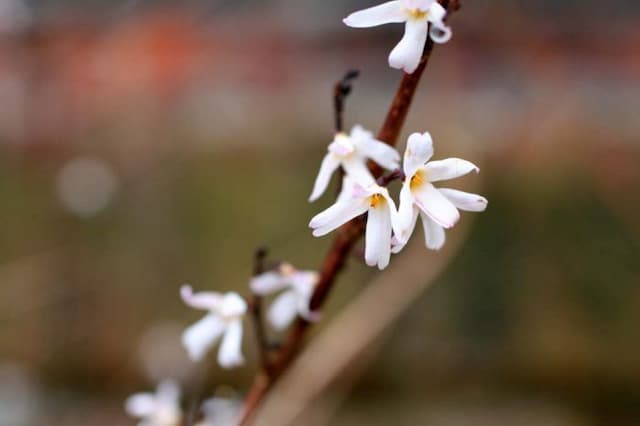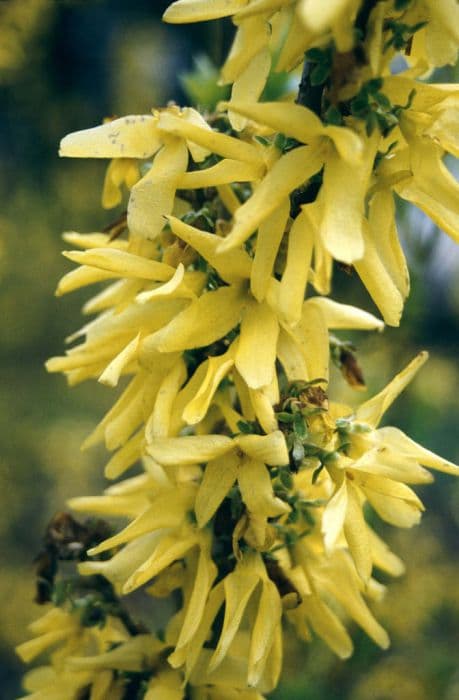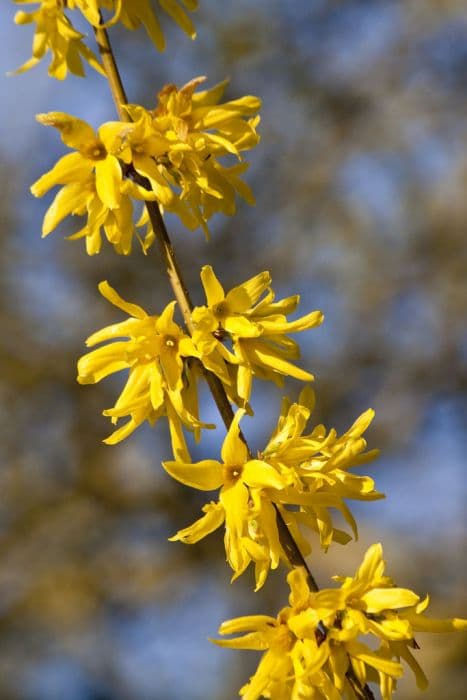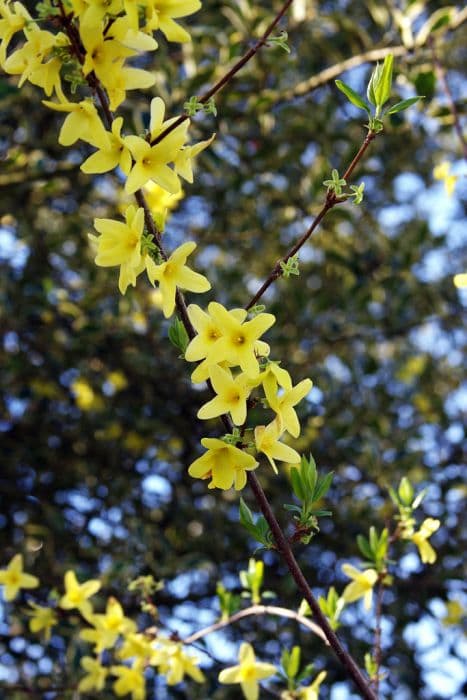Golden Bells Forsythia 'Fiesta' (v)

ABOUT
The Forsythia 'Fiesta' (v) is a vibrant and ornamental shrub that is primarily recognized for its striking flowers and foliage. During the spring season, it bursts into a spectacular display of bright yellow blooms that cover the branches before the leaves fully emerge, giving it a festive and cheerful appearance. These star-shaped flowers are a harbinger of spring, often being one of the first to bloom in the garden. The leaves of 'Fiesta' are distinctive in their own right. They are variegated, displaying a blend of green and cream or yellowish edges, adding a colorful and textured aspect to the shrub even when it's not in flower. The leaves may take on a purple hue as the temperatures drop in autumn, contributing to the all-season interest of the plant. The bark of 'Fiesta' forsythia is usually hidden beneath the dense foliage, but it can be seen as a subtle feature in the winter landscape after the leaves have fallen. The branches themselves often grow in an upright and slightly arching manner, creating a graceful form that can be attractive even in dormancy. In summary, Forsythia 'Fiesta' (v) displays a joyful array of yellow blooming flowers in early spring, complemented by a backdrop of uniquely patterned variegated leaves throughout the growing season, making it a delightful addition to any ornamental garden seeking a splash of color and varied textures.
About this plant
 Names
NamesFamily
Oleaceae
Synonyms
Golden Bells, Border Forsythia, Easter Tree
Common names
Forsythia x intermedia 'Fiesta'
 Toxicity
ToxicityTo humans
Forsythia, including the Forsythia 'Fiesta' cultivar, is generally considered non-toxic to humans. There are no well-documented cases of poisoning from ingesting this plant. Consequently, no specific symptoms have been widely reported, and there are no significant consequences expected from ingesting parts of the Forsythia 'Fiesta' plant.
To pets
Forsythia, which includes the Forsythia 'Fiesta' variant, is typically recognized as non-toxic to pets such as dogs and cats. Ingesting this plant should not cause any severe symptoms of poisoning in pets. As such, there are no specific adverse health consequences anticipated if a pet consumes parts of the Forsythia 'Fiesta' plant.
 Characteristics
CharacteristicsLife cycle
Perennials
Foliage type
Deciduous
Color of leaves
Variegated
Flower color
Yellow
Height
3-4 feet (0.9-1.2 meters)
Spread
4-5 feet (1.2-1.5 meters)
Plant type
Shrub
Hardiness zones
5
Native area
Europe Asia
Benefits
 General Benefits
General Benefits- Decorative Appeal: The Forsythia 'Fiesta' boasts unique variegated leaves and bright yellow flowers, adding aesthetic value to gardens and landscapes.
- Early Blooming: As an early spring bloomer, this plant provides early seasonal color when few other plants are in bloom.
- Wildlife Attraction: Its flowers attract pollinators such as bees and butterflies, which are beneficial for the garden's ecosystem.
- Low Maintenance: Forsythia 'Fiesta' is known for being easy to care for, requiring minimal pruning and being tolerant of a variety of soil conditions.
- Drought Tolerance: Once established, it is relatively drought-resistant, making it suitable for gardens with less frequent watering.
- Rapid Growth: It has a fast growth rate, which helps quickly establish screens or hedges for privacy or windbreaks.
- Adaptability: Forsythia 'Fiesta' can adapt to a range of environmental conditions, from urban areas to different soil types.
- Seasonal Interest: The plant offers multi-season interest, with attractive foliage that changes throughout the seasons and bright flowers in spring.
- Easy Propagation: It can be easily propagated by cuttings, making it simple for gardeners to create more plants for other areas of their garden or to share with others.
 Medical Properties
Medical PropertiesThis plant is not used for medical purposes.
 Air-purifying Qualities
Air-purifying QualitiesThis plant is not specifically known for air purifying qualities.
 Other Uses
Other Uses- Natural Dye: Forsythia flowers can be used to create a beautiful yellow natural dye for fabrics or in arts and crafts.
- Photography: Forsythia branches create an excellent early spring backdrop for outdoor and macro photography due to their bright yellow blossoms.
- Educational Tool: Forsythias can be used in educational settings to teach about plant biology and the changes that occur in plants during the spring.
- Culinary Garnish: Although not commonly consumed, forsythia blossoms can be used as an edible garnish for a splash of color on plates and desserts.
- Floral Arrangements: Forsythia branches can be forced to bloom indoors and used in cut floral arrangements to bring early spring indoors.
- Habitat Provision: Forsythia bushes can provide shelter for small wildlife, such as birds and beneficial insects, in the garden.
- Lei Making: The flowers, when strung together, can make vibrant and seasonal lei in locations where forsythias are abundant.
- Children's Crafts: The flexible branches can be used to create wreaths and crowns for children's activities and games.
- Special Occasions: In some cultures, forsythia flowers symbolize anticipation and can be used in decorations for festivals or events celebrating spring.
- Soil Erosion Control: The dense root system of forsythia shrubs helps stabilize soil on slopes, preventing erosion.
Interesting Facts
 Feng Shui
Feng ShuiThe Forsythia is not used in Feng Shui practice.
 Zodiac Sign Compitability
Zodiac Sign CompitabilityThe Forsythia is not used in astrology practice.
 Plant Symbolism
Plant Symbolism- Anticipation: Forsythias, including the 'Fiesta' variety, are among the first plants to bloom in spring, symbolizing the anticipation of new beginnings and warmer days.
- Optimism: The bright yellow flowers are seen as a sign of optimism and joy, as they bring color back to the landscape after winter's cold.
- Liveliness: Forsythia's vibrant blooms embody liveliness and energy, representing the vigorous life force and dynamic growth.
 Water
WaterGolden Bells should be watered deeply, allowing the soil to be moist but not waterlogged. During its growing season in spring and summer, water the plant about once a week, but always check the top inch of the soil for dryness before watering. If the soil is still moist, you can wait a few more days before watering. A good rule of thumb is to provide about one gallon of water per plant for each watering session, ensuring the water reaches the root zone. Reduce watering frequency in fall and winter when the plant is dormant, watering only enough to prevent the soil from drying out completely, which might be once every two to three weeks depending on the climate.
 Light
LightGolden Bells thrive best in full sun to partial shade. Ideally, place the plant in a location where it will receive a minimum of six hours of direct sunlight each day. Some afternoon shade can be beneficial, especially in hotter climates, to prevent scorching of the foliage. The plant can tolerate some light shade, but flowering may be reduced in these conditions.
 Temperature
TemperatureGolden Bells are hardy and can tolerate a wide range of temperatures. They can survive winter temperatures as low as -20 degrees Fahrenheit, making them suitable for many temperate regions. The ideal temperature for robust growth and blooming is between 60 and 75 degrees Fahrenheit during the day. The plant can handle summer highs up to the mid-90s, but prolonged heat above this range may stress the plant.
 Pruning
PruningPrune Golden Bells immediately after they finish blooming in spring to maintain their shape and size. This is also the best time to remove any dead or damaged branches to encourage healthy new growth. Typically, pruning is done once a year, but light trimming can be done throughout the growing season to keep the plant tidy. Regular pruning helps stimulate the growth of flower buds for the following year.
 Cleaning
CleaningAs needed
 Soil
SoilGolden Bell 'Fiesta' thrives in a well-draining, loamy soil enriched with organic matter. The soil pH should range from slightly acidic to neutral, between 6.0 and 7.5, to promote the healthiest growth and flowering.
 Repotting
RepottingGolden Bell 'Fiesta' does not generally require frequent repotting; it is typically repotted every 2-3 years or when it has outgrown its current container.
 Humidity & Misting
Humidity & MistingGolden Bell 'Fiesta' is adaptable to a range of humidity levels and can grow in average outdoor humidity without any special requirements.
 Suitable locations
Suitable locationsIndoor
Place in bright, indirect light and keep soil moderately moist.
Outdoor
Plant in full sun to partial shade; ensure soil drains well.
Hardiness zone
5-8 USDA
 Life cycle
Life cycleForsythia 'Fiesta', commonly known as golden bell, begins its life cycle as a seed that germinates, typically in the spring, when the soil temperature and moisture levels are appropriate. After germination, the seedling emerges and begins to develop roots and shoots; it then enters a phase of rapid vegetative growth, forming a woody stem and foliage. The plant experiences a growth spurt in the spring and summer, during which it focuses energy on expanding its branches and leafing out, with its variegated foliage being a notable characteristic. As the plant matures, usually by its second or third year, it develops flower buds in late summer or fall, which remain dormant over winter. In early spring, before the leaves emerge, Forsythia 'Fiesta' bursts into bright yellow flowers that cover the branches, providing one of the first signs of spring in the landscape. After flowering, the plant sets seeds, completes its reproductive cycle, and then enters a period of dormancy during the cold winter months, conserving energy for the next growing season.
 Propogation
PropogationPropogation time
Early Spring
The Forsythia 'Fiesta', commonly known as the variegated Forsythia, is typically propagated through softwood cuttings. This method involves taking a 4 to 6-inch (10 to 15 cm) cutting from a healthy, new growth stem in late spring to early summer when the plant has lush, green, and immature stems that have not yet become woody. The leaves on the lower half of the cutting should be removed, and the cut end can be dipped in rooting hormone to encourage root development. The prepared cutting should then be placed in a potting mix that offers good drainage. The pot should be kept moist and in a warm place with indirect light until the cutting establishes roots, usually within a few weeks, after which it can be transplanted to its permanent location.







